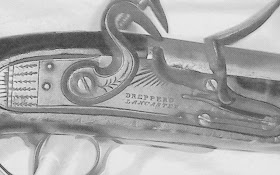 |
| The birthplace of the Pennsylvania Long Rifle. This is the Martin Meylin Gunshop near Willow Street, PA. It was in 1704 that Meylin made what is supposed to be the first Pennsylvania Long Rifle. |
 |
| The Lancaster Coin Club produced this commemorative gold coin in honor of the "Hub of Colonial Gunsmithing - 1720-1820. |
 |
| A display of flintlock Pennsylvania Long Rifles at the Landis Valley Village and Farm Museum. |
 |
| A beautiful flintlock Pennsylvania Long Rifle made from Maple wood. |
 |
| Ornamental pan primer and powder horn for a flintlock rifle. |
 |
| Display at Landis Valley that shows the caliber of shot. |
 |
| This final frame shows a flintlock Pennsylvania Long Rifle made by John Drepperd who was a gunsmith in Lancaster, Pennsylvania. |





Absolutely NO evidence exist to show Martin Mylin made the first American long rifle. It is myth of preposterous dimensions.
ReplyDeleteWith all the research you've done on the Pa Long rife, have you ever researched "Johannes Bonawitz and would you know who he did his apprenticeship with.
ReplyDeleteI haven't heard the name before. I'm sure the rifle expert at the Landis Valley Farm Museum would be able to help you. The rifle shop at the museum is amazing and the people who work there are very knowledgable. You may be able to go online to their website and leave a note asking to have the rifle expert call or email you. Good luck and I'm sorry I can't be of any help.
ReplyDeleteThe Meylans did not arrive in America until 1710- Maybe he brought it with him on the ship ?
ReplyDeleteI am a descendant of Robert Baker, the first longrifle gunsmith in Lancaster County. He established his gunshop in 1719. Meylan was not the first, as far as legal records can determine. I have the legal papers. Jan Swart janswart2000@yahoo.com
ReplyDeletehttps://www.morphyauctions.com/jamesdjulia/item/3352-369/
DeleteI would love to view the papers sometime. Maybe I should add another story based on legal records, which I didn't have when I wrote the story. I was basing my story on the historians at Landis Valley Farm Museum. How could I access your records? Many thanks for posting your response. LDub
ReplyDelete